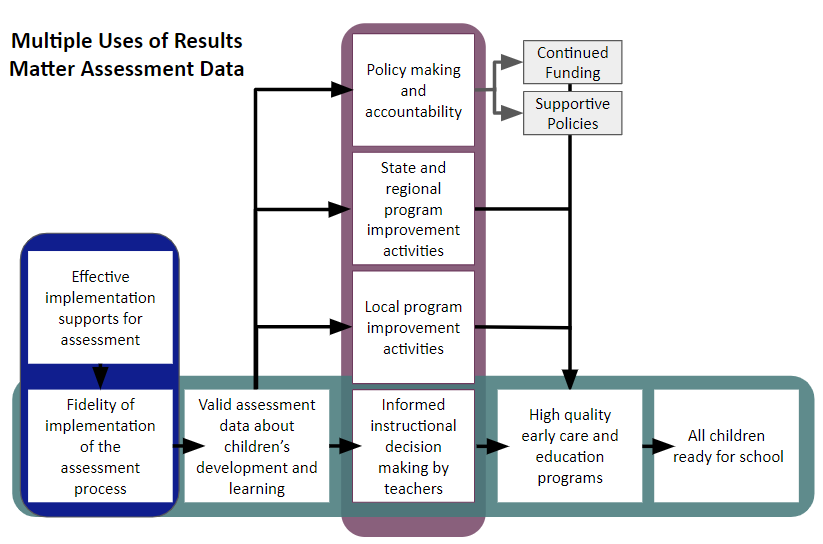You are here
Data Analysis and Improving Preschool Outcomes for Children with Disabilities
Data-Based Decision Making
Decision makers are everywhere: educators, principals, families, policymakers, just to name a few. Data-based problem solving and decision-making is an essential component of high quality programs that foster a culture of data use and is defined as a consistent process used by stakeholder teams and applied at multiple levels to analyze and evaluate relevant information to plan and implement strategies that support sustainable improved student and system outcomes. Results Matter assessment information is used for:
- Planning individual and classroom instruction
- Partnering with families
- Informing classroom and program-wide improvement strategies
- Resource allocation
- Accountability and program evaluation

How Results Matter Data is Used
The Purpose of Early Childhood Assessment in Preschool Through 3rd Grade
Results Matter provides meaningful assessment data that can be used to make decisions at several levels. At higher levels, public reports are always aggregated and never reveal personally identifiable information. Of course, we know children don’t grow and learn in a vacuum. When analyzed with other important information such as program quality and long-term outcomes, early childhood assessment data can provide more context about educational environments. A potential benefit is that this information can be tied to specific schools and programs in order to support continuous quality improvement efforts, family outreach, and community systems work. Services and programs can also be evaluated and held accountable to taxpayers, funders, and communities. Ultimately, these systems can improve where they are lacking and celebrate where they are strong.
We all want to see great outcomes for children. To that end, we must measure and make decisions base on those outcomes.
Data and Accountability
CDE is required to publicly report annually on each special education administrative unit’s compliance and results Indicator data, including Indicator 7 (Preschool Outcomes). In addition, as of 2017, CDE is using compliance and results data to make determinations for each AU under section 616(d) of IDEA. The OSEP Preschool Outcomes data, derived from Results Matter assessment data, are used in both processes.
Special Education Data Reports
Outcomes and Progress Monitoring
Data obtained through Results Matter are used to describe children's progress across specific developmental and educational domains. Preschool outcomes developed by the Early Childhood Technical Assistance Center and the U.S. Department of Education Office of Special Education Programs enable young children with disabilities to be active and successful participants during their early childhood years and in the future. These outcomes illustrate the integrated nature of early childhood development and allow programs and states to analyze and use data to measure individual child progress to improve systems and services.
One of the main activities of Results Matter is the measurement and reporting of child outcomes to the Office of Special Education Programs (OSEP). This is the progress that children make during their preschool years from the time they enter special education until they exit preschool special education, usually when they transition to Kindergarten.
Preschool Outcomes
Preschool outcomes are measured through authentic assessment practices through which providers and families observe children in their everyday routines, activities, and places and collect documentation that illustrates what children know and are able to do in areas key to future success. Three early child outcomes are used nationwide to reflect the integrated nature of child learning and development and to make it possible for comparable data from a variety of assessment instruments to be combined for further analyses.
The three child outcomes are:
-
Children have positive social skills including positive social relationships.
-
Children acquire and use knowledge and skills including language and early literacy.
-
Children take appropriate action to meet their needs.
These outcomes are measured by:
-
Percent of children who enter below age expectations who made greater than expected growth.
-
Percent of children who exited within age expectations.
Explore Colorado Preschool Outcomes Data 2024-25
Resources
- Watch the Child Outcomes Step By Step Video
- Breadth of the Three Child Outcomes (PDF) infographic from ECTA and DaSy, August 2021
- Family and Child Outcomes for Early Intervention and Early Childhood Special Education (PDF) from the Early Childhood Outcomes Center (ECO), April 2005
- Early Childhood Technical Assistance Center (ECTA) - Information on building systems and practices to improve outcomes.
- Office of Special Education Programs (OSEP) - U.S. Department of Education's Early Learning web site.
For more information about early childhood assessment, go to the Early Childhood Assessment webpages.
Administrative Data Use Self-Assessment
Effective use of administrative data—that is, information about children, families, and providers collected and maintained as part of program operations—is important to administrators and educators in understanding children’s developmental progress, assessing program effectiveness, and making programmatic and operational decisions. Yet, even when programs see the benefits of data use, administrators and educators struggle with deciding how to use data.
The Early Childhood Data Use Self-Assessment Tool is designed to support early childhood program staff interested in building their capacity to use data to inform, plan, monitor, and make decisions for program improvement. The checklist is organized around three key elements: Planning for Data Use, Using and Communicating Data, and Self-Reflection and Monitoring.The tool also contains an appendix with a variety of resources linked to each indicator in order to help illustrate what each indicator looks like in practice and how administrators can support their staff in these areas.


Connect With Us





